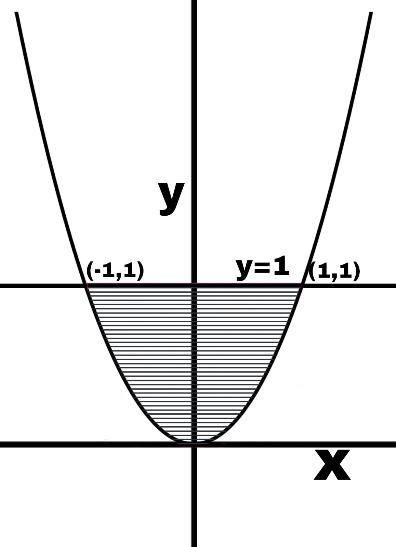
What is the area of parabola ${{x}^{2}}=y$ bounded by the line $y=1$
A. $\dfrac{1}{3}$ sqr unit
B. $\dfrac{2}{3}$ sqr unit
C. $\dfrac{4}{3}$ sqr unit
D. 2 sqr unit
Answer
220.8k+ views
Hint: In this question, We get the equation of parabola such as ${{x}^{2}}=y$ because when we put the value of x as 0,1,2 and also negative values such as 0, -1, -2 and so on in given equation we will get values of y value on the y-axis as 0, 1, 4 and negative values of on squaring change to positive values as 0, 1, 4 and so on. In this way, we get a parabolic curve by which putting on the axis graph two points such as the (0, 0), (1, 1), (2, 4) and for a negative value of x such as (0, 0), (-1, 1), (2, 4) and so on. After forming the curve we need to cut the parabolic curve at $y=1$ and integrate the cure with limits (limit from one point to another for which area needs to find).
Formula Used: $\int {{x}^{n+1}}dx=\dfrac{{{x}^{n+1}}}{n+1}$
Area of triangle = $\dfrac{1}{2}\times base\times height$
Complete step by step Solution:
\[\dfrac{1}{4}\]Given that,
${{x}^{2}}=y$is equation of the parabola, which is passing through the origin (0,0)
Here standard equation of a parabola is $y=4ax$
Where a is the focus point of the parabola (0, a)
By comparing the given equation with the standard equation of the parabola we get
(0, a) is the focus point of the parabola by comparing with the given equation coordinates of focus
A=\[\dfrac{1}{4}\]
(0, \[\dfrac{1}{4}\]) is the focus points of given equation ${{x}^{2}}=y$
$\left( a\ge 0 \right)$ so, the parabola opens upwards
We need to find the area of the bounded region made by equations ${{x}^{2}}=y$ and $y=1$

Hence the parabola is symmetrical about the y-axis
Required equation =$\int\limits_{0}^{1}{\left( 1-{{x}^{2}} \right)}dx$
Here we need to find the relation between x and y
\[\begin{align}
& \int\limits_{0}^{1}{\left( 1-{{x}^{2}} \right)}dx \\
& \int\limits_{0}^{1}{\left( dx-{{x}^{2}}dx \right)} \\
& \int\limits_{0}^{1}{\left( x-\dfrac{{{x}^{3}}}{3} \right)} \\
& \left( x-\dfrac{{{x}^{3}}}{3} \right)_{0}^{1} \\
& \left( 1-\dfrac{1}{3} \right) \\
& \dfrac{2}{3} \\
\end{align}\]
Here this is the area of one segment by multiplying by 2 we get the whole area
$\begin{align}
& \dfrac{2}{3}\times 2 \\
& \dfrac{4}{3} \\
\end{align}$
Therefore, the correct option is (C).
Note:While proceeding in question, read the question carefully. While doing integration you should know the concept of integration and carefully use the right formula if you used the wrong formula you get the wrong answer . In definite integration carefully put write boundary points or limit points. In this question as the bounded curve is assumed downward so we modified the given equation in such as the resultant equation left with the x variable. As the curve is divided into two halves so we integrate one half and multiply the resultant area of half cure with 2 so, that we get the total area of the curve.
Formula Used: $\int {{x}^{n+1}}dx=\dfrac{{{x}^{n+1}}}{n+1}$
Area of triangle = $\dfrac{1}{2}\times base\times height$
Complete step by step Solution:
\[\dfrac{1}{4}\]Given that,
${{x}^{2}}=y$is equation of the parabola, which is passing through the origin (0,0)
Here standard equation of a parabola is $y=4ax$
Where a is the focus point of the parabola (0, a)
By comparing the given equation with the standard equation of the parabola we get
(0, a) is the focus point of the parabola by comparing with the given equation coordinates of focus
A=\[\dfrac{1}{4}\]
(0, \[\dfrac{1}{4}\]) is the focus points of given equation ${{x}^{2}}=y$
$\left( a\ge 0 \right)$ so, the parabola opens upwards
We need to find the area of the bounded region made by equations ${{x}^{2}}=y$ and $y=1$

Hence the parabola is symmetrical about the y-axis
Required equation =$\int\limits_{0}^{1}{\left( 1-{{x}^{2}} \right)}dx$
Here we need to find the relation between x and y
\[\begin{align}
& \int\limits_{0}^{1}{\left( 1-{{x}^{2}} \right)}dx \\
& \int\limits_{0}^{1}{\left( dx-{{x}^{2}}dx \right)} \\
& \int\limits_{0}^{1}{\left( x-\dfrac{{{x}^{3}}}{3} \right)} \\
& \left( x-\dfrac{{{x}^{3}}}{3} \right)_{0}^{1} \\
& \left( 1-\dfrac{1}{3} \right) \\
& \dfrac{2}{3} \\
\end{align}\]
Here this is the area of one segment by multiplying by 2 we get the whole area
$\begin{align}
& \dfrac{2}{3}\times 2 \\
& \dfrac{4}{3} \\
\end{align}$
Therefore, the correct option is (C).
Note:While proceeding in question, read the question carefully. While doing integration you should know the concept of integration and carefully use the right formula if you used the wrong formula you get the wrong answer . In definite integration carefully put write boundary points or limit points. In this question as the bounded curve is assumed downward so we modified the given equation in such as the resultant equation left with the x variable. As the curve is divided into two halves so we integrate one half and multiply the resultant area of half cure with 2 so, that we get the total area of the curve.
Recently Updated Pages
In a game two players A and B take turns in throwing class 12 maths JEE_Main

The number of ways in which 6 men and 5 women can dine class 12 maths JEE_Main

The area of an expanding rectangle is increasing at class 12 maths JEE_Main

If y xxx cdots infty then find dfracdydx A yxy 1 B class 12 maths JEE_Main

Mutually Exclusive vs Independent Events: Key Differences Explained

Area vs Volume: Key Differences Explained for Students

Trending doubts
JEE Main 2026: Application Form Open, Exam Dates, Syllabus, Eligibility & Question Papers

Derivation of Equation of Trajectory Explained for Students

Hybridisation in Chemistry – Concept, Types & Applications

Understanding the Angle of Deviation in a Prism

How to Convert a Galvanometer into an Ammeter or Voltmeter

Degree of Dissociation: Meaning, Formula, Calculation & Uses

Other Pages
JEE Advanced Marks vs Ranks 2025: Understanding Category-wise Qualifying Marks and Previous Year Cut-offs

Ideal and Non-Ideal Solutions Explained for Class 12 Chemistry

Understanding the Electric Field of a Uniformly Charged Ring

Understanding Electromagnetic Waves and Their Importance

Understanding Collisions: Types and Examples for Students

Understanding Atomic Structure for Beginners




